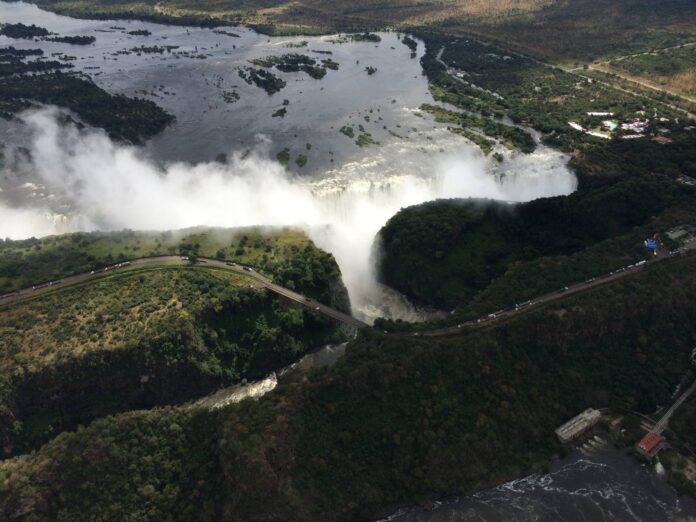Sydney Kawadza
Authorities involved in the construction of the 2 400mW Batoka Gorge Hydro-electric Scheme have agreed to reduce the dam size to salvage tourism activities around the world famous Victoria Falls.
Environmental and Social Impact Assessment and associated Environmental and Social Management Plans revealed serious negative impact on adventure tourism among other interests.
The ESIA reports are undergoing disclosure to interested and affected stakeholders as well as the general public to provide comments and concerns regarding the planned development of the scheme.
The BGHES on the Zambezi River, is located 47 km downstream of the Victoria Falls.
A consortium comprising China’s Power Construction Corporation and General Electric, of the USA, has been selected to develop the US$4 billion project.
Under the current schedule, it is anticipated that the BGHES scheme – comprising a 175-m-high dam wall and two 1 200mW power plants on either side of the river.
It would also include a substation, transmission, township and road infrastructure and could begin producing electricity from the second half of 2028 onwards.
However, according to the ESIA reports, the scheme has significant implications for the adventure and nature-based tourism industries that have developed over the past three-and-a-half decades around the Victoria Falls.
The surrounding national parks, on either side of the Falls – the Victoria Falls National Park, in Zimbabwe, and the Mosi-oa-Tunya National Park, in Zambia – would also be affected.
“Once the gorge is inundated, the Zambezi’s world-renowned white-water rafting activities would be severely curtailed, with rafting impossible during the high-water season from January to July and operations limited from rapids 1 to 10 during the low-water season, from August to December.
“The consequences were likely to be severe for the ten rafting companies operating in the area, which employ about 300 people.
“It would also negatively affect tourism revenue, with white-water rafting a large contributor to the estimated US$3.4-million in yearly tourism value downstream of the falls.”
The ESIA further suggests that economic-displacement compensation would have to be considered by the two governments.
It also indicates that tourism associated with the region’s unique birdlife could be affected, owing to the loss of bird habitat associated with reservoir inundation.
However, in a statement Zimbabwe River Authority chief executive Engineer Munayaradzi Munodawafa said mitigation measures include the decision to limit the dam height to 175m instead of building the dam to the top of the gorge.
This, he said, would prevent the water backflow from reaching and impacting areas of special interest such as the Victoria Falls, the existing ZESCO Limited Power Station, the Victoria Falls and Mosi-o-Tunya National Parks.
“The other measures highlighted included the adopted reservoir operation rules that were developed with a view to ensure the balancing of power generation whilst allowing for the continuation of other river-based activities and environmental flows (e-flows).
“This includes activities such as White-Water Rafting and e-flows that would support the continued existence of downstream ecosystems.
“In that regard, comments and questions raised during the engagements were documented and will be used in the updating of the draft ESIA report and the associated Environmental and Social Management Plans (ESMP).”
The ESIA reports disclosure and stakeholder engagement process will continue up to the closing date of January 25 next year for receiving of concerns and comments regarding the planned implementation of the project.
“Through the ESIA studies and the concluded disclosure process, the Authority’s objective is to further refine the measures detailed in the ESMP’s aimed at mitigating the identified potential negative impacts as well as the enhancement measures for the identified positive impacts.
“The authority will also take advantage of the outputs of the Hydropower Sustainability Assessment Protocol (HSAP) assessment that it carried with support from the World Bank during the planning phase of the project and work with renowned international experts in developing and implementing additional programs aimed at enhancing all the sustainability factors and aspects of the project,” Eng Munodawafa said.
Among the social and economic benefits for communities are the 4,000 direct plus 6,000 indirect jobs to be created during the construction of the BGHES project infrastructure.
The construction is expected to start in the fourth quarter of 2021.
Host communities will be given priority for them to fully take advantage of the construction and tourism sector work and business opportunities the project will present including under the associated supply chains and service industries.
The project is also expected to improve access to electricity among the host communities while adding to the electricity generation capacity of Zimbabwe and Zambia.
“Further, the lives of numerous communities, especially those to be directly impacted by the project both in Zambia and Zimbabwe will be enhanced through sustainable Corporate Social Responsibility programmes to be implemented as part of the project scope.”
ZARA working with local authorities and host communities in both countries is rolling out a similar programme for the communities affected by the development of the Kariba Dam project called the Zambezi Valley Development Fund (ZVDF).
“This programme, whose objective is to transform the lives of the host communities has been supporting the implementation of community infrastructure projects such as building of schools, health facilities, drilling boreholes and supporting agricultural initiatives.
“As a responsible corporate citizen, the Authority will continue supporting such programmes in its areas of operation aimed at enhancing access to health, education services and water supply in addition to improved livelihoods.
“The authority is pleased to note that some stakeholders have also started positioning themselves to take advantage of the planned construction of the Batoka Gorge Hydro-Electric Scheme.”
Hwange Rural District Council is planning to develop a multi-million-dollar Iconic City near the project site so as to take advantage of the economic benefits which will arise from the implementation of the BGHES.
A similar project is expected to be unveiled by the Mukuni Development Trust in Livingstone, Zambia.
“Such undertakings will bring about numerous indirect jobs to benefit thousands of Zambians and Zimbabweans.
“The authority, therefore, foresees major economic benefits which will positively impact the two countries and generate revenue of over USD$750 million annually which will enhance the GDP of the two Contracting States,” Eng Munodawafa said.
ZARA, is a bi-national organisation equally owned by Zimbabwe and Zambia, is currently finalising preparatory activities for the implementation of BGHES.
To ensure the sustainable implementation of this multi-billion-dollar hydro power project, a broad range of specialist studies have been undertaken including the updating of the 1993 Engineering Feasibility Studies.














